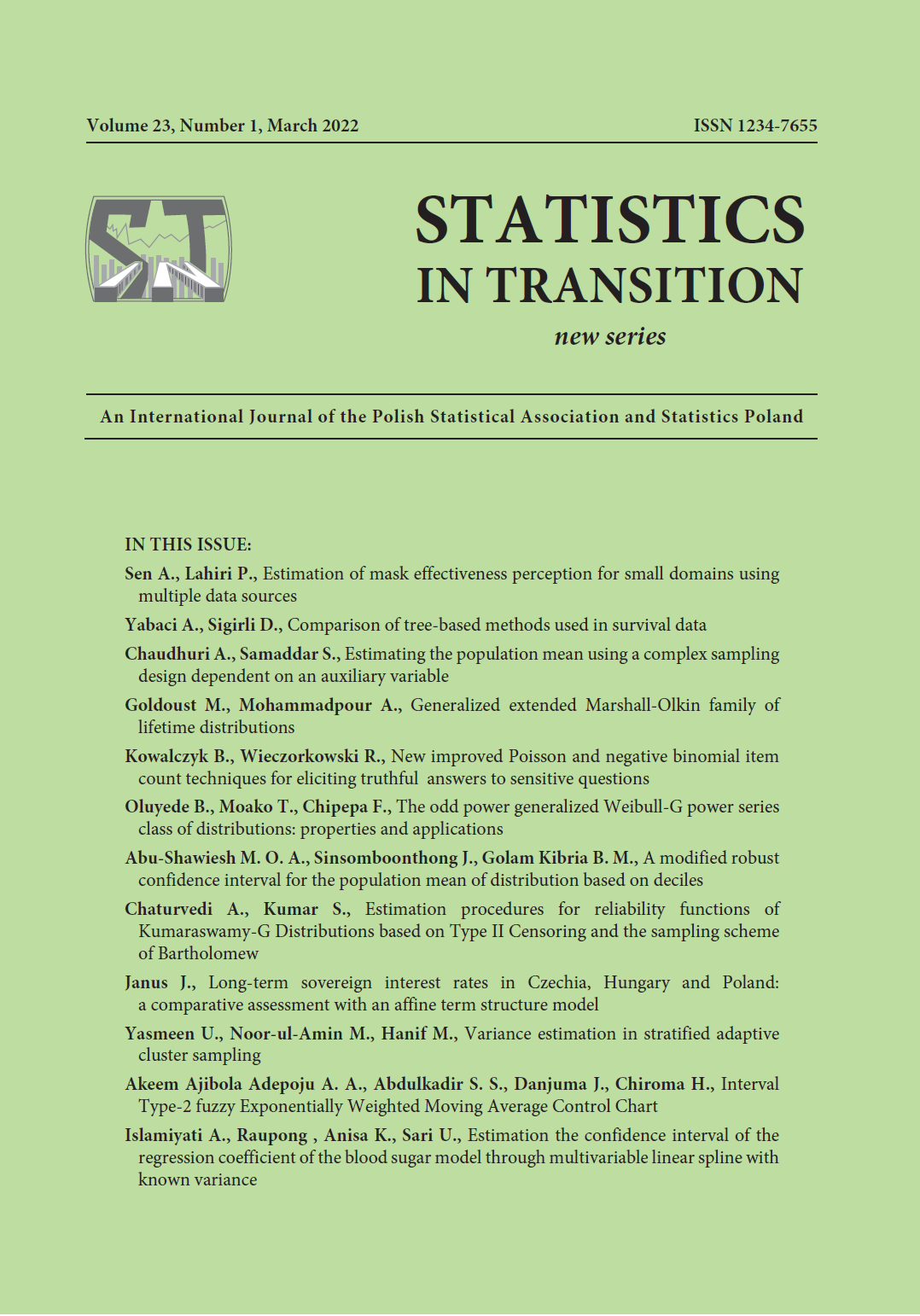ARTICLE
ABSTRACT
We introduce a new generalized family of nonnegative continuous distributions by adding two extra parameters to a lifetime distribution, called the baseline distribution, by twice compounding a power series distribution. The new family, called the lifetime power series-power series family, has a serial arrangement of parallel structures, which extends the Marshall and Olkin structure. Four special models are discussed. A mathematical treatment of the new distributions is provided, including ordinary and incomplete moments, quantile, moment generating and mean residual functions. The maximum likelihood estimation technique is used to estimate the model parameters and a simulation study is conducted to investigate the performance of the maximum likelihood estimates. Its applicability is also illustrated by means of two real data sets.
KEYWORDS
compound distribution, hazard rate function, lifetime distribution, maximum likelihood estimation, power series distribution
REFERENCES
Aarset, M. V., (1987). How to identify bathtub hazard rate. IEEE Transactions on Reliability, 36, pp. 106–108.
Adamidis, K., Dimitrakopoulou, T., and Loukas, S., (2005). On a generalization of the exponential geometric distribution. Statistics and Probability Letters, 73, pp. 259–269.
Adamidis, K., and Loukas, S., (1998). A lifetime distribution with decreasing failure rate. Statistics and Probability Letters, 39, pp. 35–42.
Al-Aqtash, R., Lee, C., and Famoye, L., (2014). Gumbel-Weibull Distribution: Properties and Applications. Journal of Modern Applied Statistical Methods, 13, pp. 201–225.
Al-Mheidat, M., Famoye, F., and Lee, C., (2015). Some generalized families of Weibull distribution: Properties and applications. International Journal of Statistics and Probability, 4, pp. 222–238.
Barreto-Souza, W., Morais, A., and Cordeiro, G.M., (2011). The Weibull-geometric distribution. Journal of Statistical Computation and Simulation, 81, pp. 645–657.
Barreto-Souza, W., Santos, A.H., and Cordeiro, G.M., (2010). The beta generalized exponential distribution. Journal of Statistical Computation and Simulation, 80, pp. 159–172.
Chahkandi M., and Ganjali, M., (2009). On some lifetime distributions with decreasing failure rate. Computational Statistics and Data Analysis, 53, pp. 4433–4440.
K. Cooray (2006). Generalization of the Weibull distribution: the odd Weibull family. Statistical Modelling, 6, pp. 265–277.
Cordeiro, G.M., and Lemonte, A., (2011). The ß Birnbaum-Saunders distribution: An improved distribution for fatigue life modeling. Computational Statistics and Data Analysis, 55, pp. 1445–1461.
Eichhorn, S.J., and Davies, G.R., (2005). Modelling the crystalline deformation of native and regenerated cellulose. Cellulose, 13, pp. 291–307.
Famoye, F., Lee, C., and Olumolade O., (2005). The beta-Weibull distribution. Journal of Statistical Theory and Application, 4, pp. 122–136.
Flores, J., Borges, C., Cancho, V.G., and Louzada F., (2013). The complementary exponential power series distribution. Brazilian Journal of Probability and Statistics, 27, pp. 565–584.
Greenwood, J.A., Landwehr, J.M., and Matalas, N.C., (1979). Probability weighted moments: Definition and relation to parameters of several distributions expressable in inverse form. Water Resources Research, 15, pp. 1049–1054.
Gurland, J., and Sethuraman, J.,(1994). Reversal of increasing failure rates when pooling failure data. Technometrics, 36, pp. 416–418.
Hassan, M.,Larson, L.E., Leung V.W., and Asbeck, P.M., (2012). A combined seriesparallel hybrid envelope amplifier for envelope tracking mobile terminal RF power amplifier applications. IEEE Journal of Solid-State Circuits, 47, pp. 1185–1198.
Kazimierczuk, M.K., Thirunarayan, N., and Wang S., (1993). Analysis of series-parallel resonant converter. IEEE transactions on aerospace and electronic systems, 29, pp. 88–99.
Kenney, J., and Keeping., E., (1962). Mathematics of Statistics. Volume 1, Third edition, Van Nostrand, Princeton.
Marshall, A.W., and Olkin, I., (1997). A new method for adding a parameter to a family of distributions with application to the exponential and Weibull families. Biometrika, 84, pp. 641–652.
Morais, A.L., and Barreto-Souza, W., (2011). A compound class of Weibull and power series distributions. Computational Statistics and Data Analysis, 55, pp. 1410–1425.
Munteanu, B.G., Leahu, A., and Pârtachi, I., (2014). The max-Weibull power series distribution. Analele UniversitY Oradea Fasc. Matematica, 21, pp. 133–139.
Nadarajah, S., and Kotz, S., (2006). The beta exponential distribution. Reliability Engineering & System Safety, 91, pp. 689–697.
Nassar, M., Kumar, D., Dey, S., Cordeiro, G.M., and Afify, A.Z., (2019). The Marshall- Olkin alpha power family of distributions with applications. Journal of Computational and Applied Mathematics, 351, pp. 41–53.
Nicholas, M.D., and Padgett W.G., (2006). A bootstrap control chart for Weibull percentiles. Quality and Reliability Engineering International, 22, pp. 141–151.
Proschan, F., (1963). Theoretical explanation of observed decreasing failure rate. Technometrics, 5, pp. 375–383.
Ross, S.M., (2010). Introduction to Probability Models. Academic Press, Boston, 10th edition.
Shanker, R., Shukla, K.K., (2019). A generalization of Generalized Gamma distribution. International Journal of Computational and Theoretical Statistics, 6, pp. 33–42.
Shanker, R., Shukla, K.K., (2019). A generalization of Weibull distribution. Reliability: Theory and Applications, 14, pp. 57–70.
Smith, R.l., and Naylor, J.C., (1987). A comparison of maximum likelihood and Bayesian estimators for the three-parameter Weibull distribution. Applied Statistics, 36, pp. 358–369.
Tahmasbi, R., and Rezaei, S., (2008). A two-parameter lifetime distribution with decreasing failure rate. Computational Statistics and Data Analysis, 52, pp. 3889–3901
Xiong,W., Zhang, Y., and Yin, C., (2009). Optimal energy management for a series-parallel hybrid electric bus. Energy Conversion and Management, 50, pp. 1730–1738.
